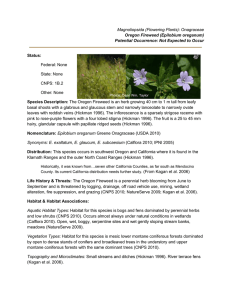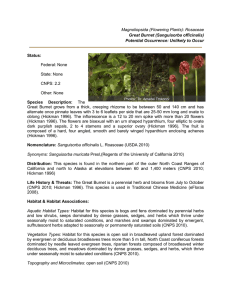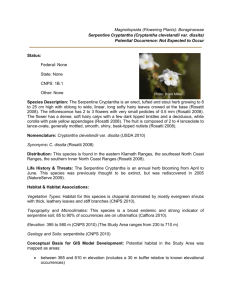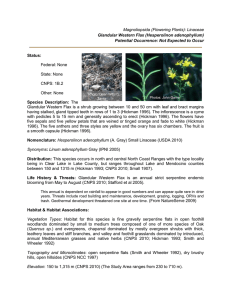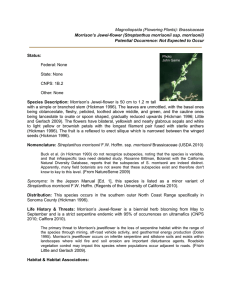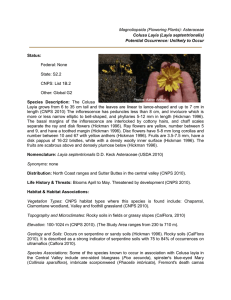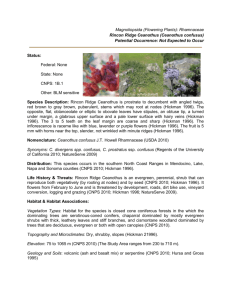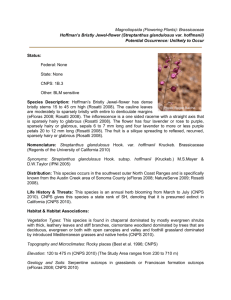CARA Text
advertisement
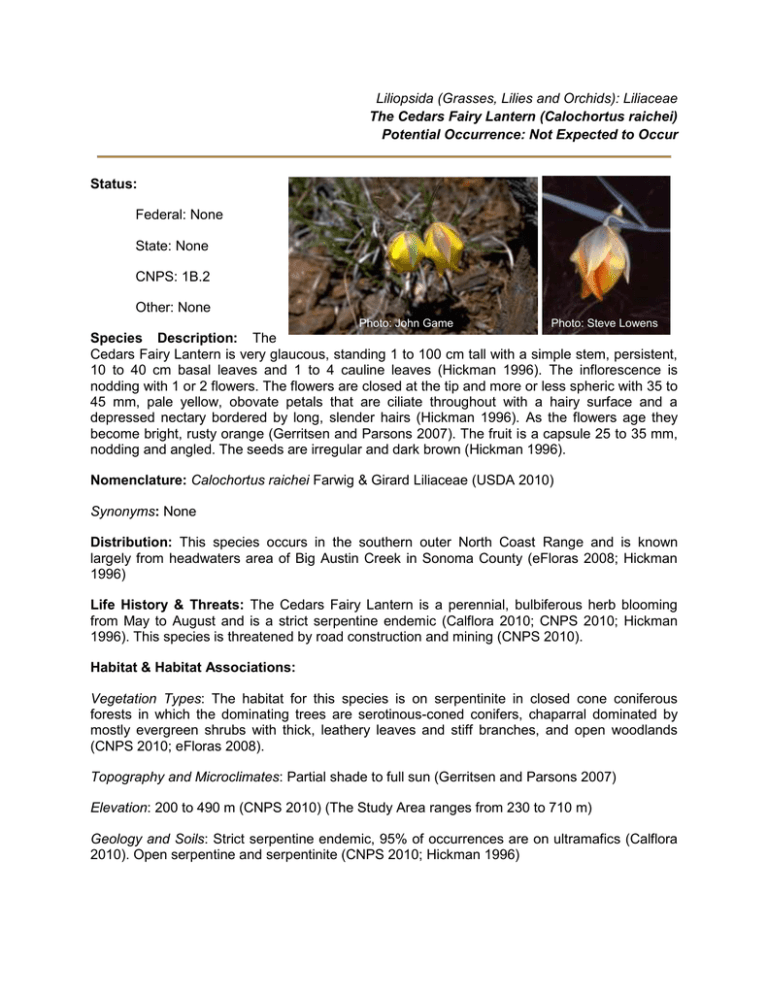
Liliopsida (Grasses, Lilies and Orchids): Liliaceae The Cedars Fairy Lantern (Calochortus raichei) Potential Occurrence: Not Expected to Occur Status: Federal: None State: None CNPS: 1B.2 Other: None Photo: John Game Photo: Steve Lowens Species Description: The Cedars Fairy Lantern is very glaucous, standing 1 to 100 cm tall with a simple stem, persistent, 10 to 40 cm basal leaves and 1 to 4 cauline leaves (Hickman 1996). The inflorescence is nodding with 1 or 2 flowers. The flowers are closed at the tip and more or less spheric with 35 to 45 mm, pale yellow, obovate petals that are ciliate throughout with a hairy surface and a depressed nectary bordered by long, slender hairs (Hickman 1996). As the flowers age they become bright, rusty orange (Gerritsen and Parsons 2007). The fruit is a capsule 25 to 35 mm, nodding and angled. The seeds are irregular and dark brown (Hickman 1996). Nomenclature: Calochortus raichei Farwig & Girard Liliaceae (USDA 2010) Synonyms: None Distribution: This species occurs in the southern outer North Coast Range and is known largely from headwaters area of Big Austin Creek in Sonoma County (eFloras 2008; Hickman 1996) Life History & Threats: The Cedars Fairy Lantern is a perennial, bulbiferous herb blooming from May to August and is a strict serpentine endemic (Calflora 2010; CNPS 2010; Hickman 1996). This species is threatened by road construction and mining (CNPS 2010). Habitat & Habitat Associations: Vegetation Types: The habitat for this species is on serpentinite in closed cone coniferous forests in which the dominating trees are serotinous-coned conifers, chaparral dominated by mostly evergreen shrubs with thick, leathery leaves and stiff branches, and open woodlands (CNPS 2010; eFloras 2008). Topography and Microclimates: Partial shade to full sun (Gerritsen and Parsons 2007) Elevation: 200 to 490 m (CNPS 2010) (The Study Area ranges from 230 to 710 m) Geology and Soils: Strict serpentine endemic, 95% of occurrences are on ultramafics (Calflora 2010). Open serpentine and serpentinite (CNPS 2010; Hickman 1996) Conceptual Basis for GIS Model Development: Potential habitat in the Study Area was mapped as areas: below 510 m elevation (A 30 m elevation buffer was added to species known elevational range) chaparral (i.e. Northern mixed chaparral) cismontane woodlands (i.e., mixed hardwoods, mixed montane hardwoods or single dominant hardwoods with canopy cover < 40%). Serpentine soils, while common regionally, are not indicated by the GIS soil data as occurring in the Study Area. No closed cone conifers are known to occur in the Study Area. Potential Occurrence in the Galbreath Wildlands Preserve: Habitat: The Cedars Fairy Lantern is a strict serpentine endemic that occurs in chaparral, open woodlands, and closed-cone coniferous forest. Habitat for this species does not occur in the Preserve. Serpentine soils, while common regionally, are not indicated by the GIS soil data as occurring in the Study Area. To verify the GIS information, we identified all areas (11 sites) of exposed rocky soils from high-resolution satellite imagery. During site visits to these areas, the only serpentine found were rocks exposed by road maintenance activity at a waterbar. Nearest Occurrence: Documented Occurrences in the Galbreath Wildlands Preserve: Previous species list for the Galbreath Wildlands Preserve did not document this species (SSU Field Station and Nature Preserves 2010). Nearest Occurrence to the Galbreath Wildlands Preserve: This species is only known from 22 occurrences in Sonoma County (Calflora 2010). The nearest occurrence is approximately 13 miles south of the Galbreath Wildlands Preserve in the Tombs Creek quad in the Gualala River watershed (Calflora 2010). Occurrence of this species on the Preserve would constitute a northern range extension. Professional Consultations: “Unless there is serpentine, and probably lots of it, it is extremely unlikely that … Calochortus raichei …[is] present.” (R. Raiche pers comm.). Summary: We anticipate the Cedars Fairy Lantern to be “Not Expected to Occur” because serpentine soils do not occur in the Preserve. References Calflora. 2010. Information on California plants for education, research and conservation.<http://www.calflora.org/> Accessed 2010 Jul 12. California Native Plant Society (CNPS). 2010. Inventory of Rare and Endangered Plants. Online edition, v7-10b. <http://www.cnps.org/inventory> Accessed 2010 Jul 12. eFloras 2008. Flora of North American. Published on the Internet <http://www.efloras.org>. Accessed 2010 Jul 12. Game J. 1998. The Cedars Mariposa Lilly Calochortus raichei. <http://calphotos.berkeley.edu/cgi-bin/img_query?rel-taxon=contains&wheretaxon=Calochortus+raichei>. Accessed 2011 May 15. Gerritsen ME, Parsons R. 2007. Calochortus: Mariposa lilies & their relatives. Portland; Timber Press, Inc. 59 p. Hickman JC editor. 1996. The Jepson Manual Higher Plants of California. 3rd printing. London: University of California Press, Ltd. 1122 p. Lowens S. 2005. Cedars Mariposa Lilly Calochortus raichei. < http://calphotos.berkeley.edu/cgibin/img_query?rel-taxon=contains&where-taxon=Calochortus+raichei>. Accessed 2011 May 15. SSU Field Stations and Nature Preserves. 2010. Galbreath Wildlands Preserve Vascular Plant List. <http://www.sonoma.edu/preserves/docs/galbreath_vascular_plants.pdf>. Accessed 2010 Jun. Raiche R. 2010. Personal communication. 2010 Jul 12. United States Department of Agriculture (USDA). 2010. PLANTS Profile. <http://plants.usda.gov/java/nameSearch?mode=symbol&keywordquery=CARA16>. Accessed 2010 Jul 17. Species Account Description: Linden Schneider


